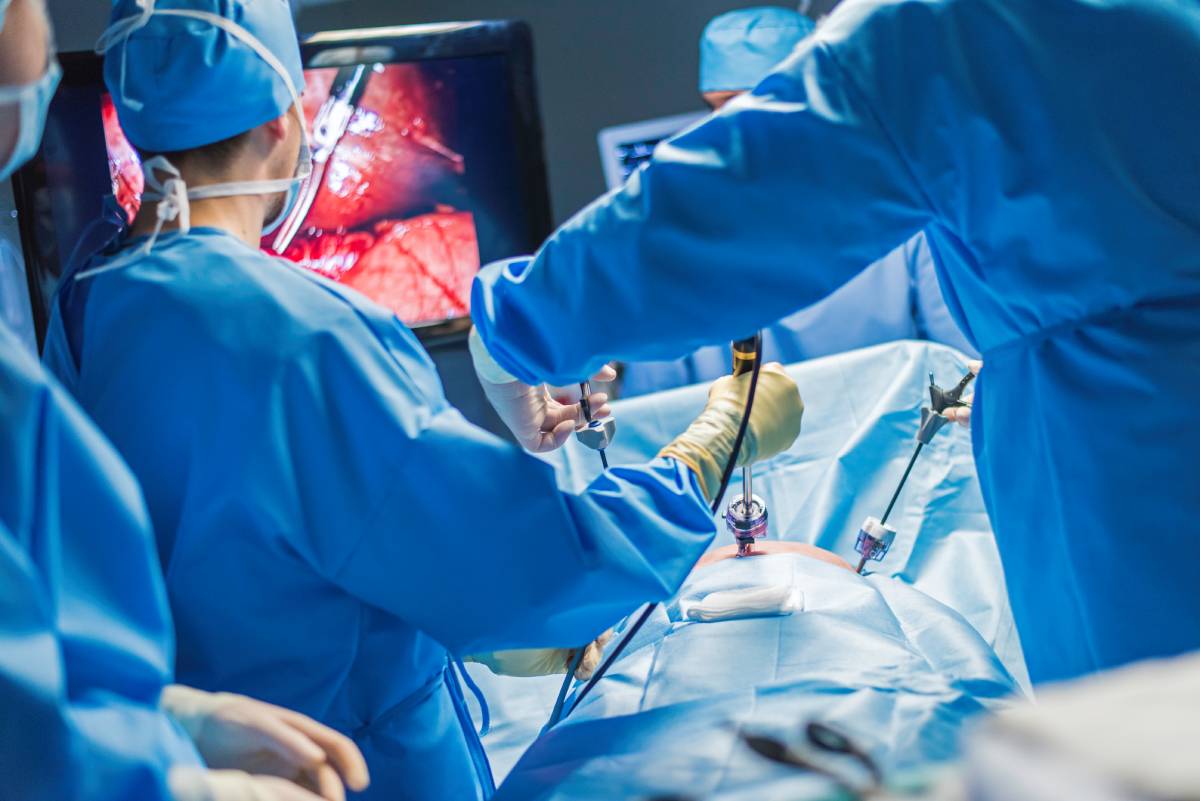Laparoscopic surgery is a type of keyhole surgery (a minimally invasive surgical procedure involving a small incision) in which a laparoscope, a thin tube with a light and camera, is inserted into the incision. Due to its minimally invasive nature, laparoscopic surgery has the benefit of a much shorter recovery period for the patient than can be expected for more invasive forms of surgery and often has minimal postoperative pain or cosmetic concerns (i.e. scarring). Because of these benefits, laparoscopic surgery has found many applications, including diagnosis or surgical treatment of diseases of the gut, uterus, liver, appendix, and/or intestines. [1]
One major category of applications of laparoscopic surgery is for the diagnosis and treatment of gastric cancers. In the wake of rigorous studies which demonstrated the safety of applying laparoscopy to both early stages of gastric cancers (for which this procedure was commonly used) and more advanced stages of gastric cancers (for which there had previously been concerns about proper resectioning), physicians have become more comfortable recommending laparoscopic gastrectomy surgery for patients with more advanced gastric cancer. While the procedure itself takes longer, lasting five to six hours as compared with three hours of open surgery, the recovery time is reduced—with patients undergoing laparoscopic surgery for gastric cancer staying at the hospital three to four days total and patients undergoing open surgery staying a total of five to seven days total on average. Patients who underwent laparoscopy are also less likely to need a feeding tube after the procedure, and Mayo Clinic posits that these patients may also be better able to tolerate perioperative chemotherapy than their counterparts who underwent open surgery for their gastric cancer. [2]
Another application of laparoscopy is toward the diagnosis and treatment of endometriosis, for which laparoscopic surgery is considered the gold standard due to its reduced recovery time, reported pain, and infection rates as compared to laparotomy (the more invasive counterpart of laparoscopy, with a larger surgical incision). [3] Another obstetric laparoscopic procedure is laparoscopic fibroid removal, a surgical procedure to remove uterine fibroids (benign growths in the uterus). Patients have two options for laparoscopic fibroid removal: laparoscopic myomectomy and laparoscopic hysterectomy. The choice between the two often hinges on whether the patient in question wants to become pregnant in the future, as the myomectomy allows for the preservation of the uterus while hysterectomy definitionally does not. Nonetheless, in either case, applications of laparoscopic techniques, sometimes combined with robotic surgical equipment, can allow for patients with complex conditions who might otherwise have needed an open surgery to have a minimally invasive procedure instead. [4]
Given the successful applications of laparoscopic surgery in various medical fields, clinical research and development into new laparoscopic surgical procedures has continued to expand over the past decades. A recent (2022) literature review reports Level I evidence demonstrating that laparoscopic surgery showed significant advantages over open surgeries in reports of numerous operations, including fundoplication for gastroesophageal regurgitation disease and bariatric surgery for weight loss, and that advanced laparoscopic surgery has been expanded into hepatectomy, pancreatectomy, urology, and gynecology. In short, laparoscopic surgery has become the normal technique for many kinds of abdominal surgery. Especially with the recent advancements in robot-assisted laparoscopic surgery, laparoscopy remains a promising field of clinical research and adaptation to make surgical procedures less painful and invasive across systems. [5]
References
(1) Laparoscopy (keyhole surgery) – NHS. https://www.nhs.uk/conditions/laparoscopy/ .
(2) Laparoscopic gastrectomy for gastric cancer – Mayo Clinic. https://www.mayoclinic.org/medical-professionals/cancer/news/laparoscopic-gastrectomy-for-gastric-cancer/mac-20430324.
(3) Zanelotti, A.; Decherney, A. H. Surgery and Endometriosis. Clin Obstet Gynecol 2017, 60 (3), 477–484. https://doi.org/10.1097/GRF.0000000000000291.
(4) Laparoscopic Fibroid Removal | Baylor Medicine. https://www.bcm.edu/healthcare/specialties/obstetrics-and-gynecology/ob-gyn-procedures/laparoscopic-fibroid-removal.
(5) Basunbul, L. I.; Alhazmi, L. S. S.; Almughamisi, S. A.; Aljuaid, N. M.; Rizk, H.; Moshref, R. Recent Technical Developments in the Field of Laparoscopic Surgery: A Literature Review. Cureus 2022, 14 (2), e22246. https://doi.org/10.7759/cureus.22246.
